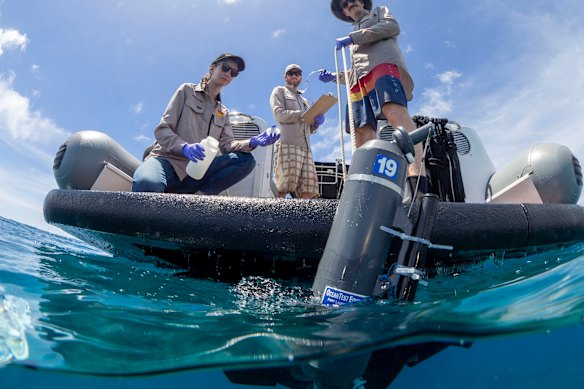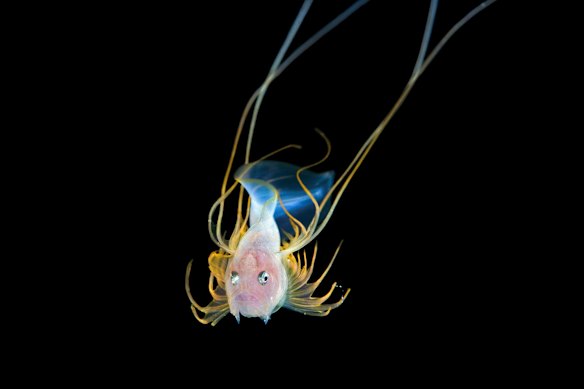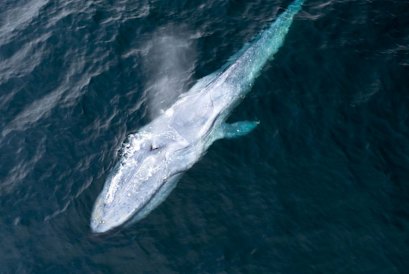
Scientists have mapped the DNA of Australia’s oceans. Their findings surprised even them.Credit: Minderoo Foundation
How do you detect the presence of a bony-eared assfish, lurking 3000 metres below the surface of the ocean? By testing for evidence of its urine, of course.
Scientists have spent the past three years painstakingly mapping the DNA of Australia’s oceans, filtering the waters to collect the DNA “breadcrumbs” animals leave behind.
From just two litres of water, they can identify the DNA of every creature that has passed through the environment over the previous hours and days, allowing them to collect evidence of the animals’ presence without nets and ropes.
A multiyear project run by Minderoo Foundation and Parks Australia, spanning 13 dedicated voyages and several secondary voyages, has identified 257,497 marine vertebrates across Australian marine parks spanning 4000 kilometres north to south, and 6000 kilometres east to west.
The environmental DNA (eDNA) project has not only spotlit where rare and threatened marine species are, but has also inadvertently discovered species previously unknown to science.

While bony-eared assfish have an unfortunate name, their delicate fins and tendrils are captivating.Credit: Alamy
“Of course, we see more of them in places like deep-sea ecosystems, where people haven’t gone before and surveyed the biodiversity down there,” said Professor Michael Bunce, the head of OceanOmics at Minderoo.
“What’s going to be crucial is putting protections around some of these special places before they disappear.”
Bony-eared assfish – a form of cusk-eel – are delicate creatures resembling a cross between a jellyfish and a tadpole, and are found in tropical and subtropical waters to depths of up to 4000 metres. Identifying them would usually involve extracting them from the depths of the ocean, thereby killing them.
Other mid- and deep-sea creatures identified by the research teams include similarly intriguingly named rattails, slimeheads, pearlfish, slickheads and lanternfish.
Despite rapid advances in scientific knowledge, oceans remain the great unknown, with estimates there could be up to 500,000 marine species in Australia’s oceans, including corals, plankton and shellfish – of which just 33,000 have been identified.
Work to sequence the DNA of marine life is slow and painstaking, but Bunce said Minderoo Foundation had set a goal to sequence the genetic “barcodes” of all 5000 known marine fish, a task that is about halfway complete. A further 500 vertebrates call Australian waters home, including seabirds, whales, sealions and dolphins.
The organisation is one of the partners of the national science agency CSIRO, which has set an ambitious target to create a national biodiversity DNA library for Australia, which it says would offer enormous fisheries, biosecurity and environmental benefits.
The $11.8 million multiyear eDNA partnership between Minderoo Foundation and Parks Australia took seawater samples from a range of ocean environments, from tropical reefs to 6000 metres below the surface of the water.
Bunce said sea creatures shed DNA in various ways, but mostly from the waste they expel.
“They’re defecating and urinating in the water columns, so we’re literally swimming around in a whole pile of DNA ... and that’s kind of cool and gross at the same time,” he said.

The largest animals on earth, blue whales, were detected in the waters off Australia.Credit: Sean Keenan
After animals shed DNA, it can be detectable for between a few hours and a few days before it is broken down by water movements, temperatures, UV radiation and other factors.
DNA is broken down more rapidly in shallow and warm waters, while in cold and dark deep-sea settings, it can persist for a week or more.
While all animals contain those genetic breadcrumbs, which are scattered through our oceans, different species lose DNA in different ways.
Bunce said turtles and sea snakes slough smaller amounts of DNA as they move through water, making them more difficult to detect, while baitfish were easily identified as they were eaten in great numbers and expelled out the back ends of larger species.
Not that there is such a thing as a perfect science – Bunce said researchers joked about the cats, dogs and salmon apparently detected in remote oceans, their DNA deposited into pristine waters from boats above.
Armed with more than a quarter of a million observations of sea creatures, the project’s leaders then turned their sights to offering their science to the Australian public, and the world.
Minderoo Foundation’s new OceanOmics eDNA Dashboard, launched today, combines artificial intelligence with eDNA to allow users to explore the data by species or marine park, or to “chat” with AI to interrogate the data.
A Minderoo spokesman said the dashboard would be “a game-changer for marine conservation as everyday Australians can now visualise the ocean in an entirely new way”.
Dr Philipp Bayer, principal of computational biology at Minderoo Foundation, said scientists had recovered more than 1.2 billion DNA sequence readings from their surveys, with each two-litre eDNA seawater sample averaging 62 different marine species detections.
Scientists made almost 258,000 marine vertebrate eDNA observations, including 2019 bony fish species and 95 cartilaginous fish (sharks, rays and chimaeras) species.
“This is a lot of data,” Bayer said. “To make sense of it all, and enable people to interact with the data, we co-developed a dashboard that allows users to explore the living fabric of our oceans at scale.
“The dashboard focuses on making complex science accessible. While we can’t see DNA, we can read it – and now we can visualise the output too.”
Environment and Water Minister Murray Watt welcomed the innovation, describing it as a game-changer for marine conservation.
“We can now ‘visualise’ the ocean in an entirely new way – from threatened handfish to whale sharks, we’re gaining insights that were unimaginable just a few years ago,” he said.
“By co-investing in world-leading science like this, we’re better equipped to protect the incredible biodiversity in our marine parks and make evidence-based decisions for the future.”
The public release of the dashboard is available at https://marine-
parks.minderoo.org
The Examine newsletter explains and analyses science with a rigorous focus on the evidence. Sign up to get it each week.